The prose originated during the Late Classic Maya period, around 900 CE, a time of profound transformation and introspection within Maya civilization. I imagine a scribe, seated by flickering torchlight beneath vaulted ceilings adorned with intricate glyphs, contemplating the passage of days, the ebb and flow of life, and the inexorable march of destiny. This scribe, steeped in the wisdom of generations and burdened by the weight of witnessing societal change, carefully inscribes his thoughts onto bark-paper codices. Through reflective prose, he ponders the fragility of existence, the cycles of nature, and the complexities of human ambition and resilience. His words are both a personal meditation and a timeless dialogue with future generations, encapsulating the spiritual and existential musings of an era at the threshold of significant cultural evolution.
“I looked up at the sky as the wind whispered around me,
my thoughts reaching into the vast unknown.
From the highest vault of the heavens,
a monstrous dragonfly’s head gleams,
reflecting shifting echoes of time.
It strikes at the hand of the unbound maker,
in the endless void.
It drinks blood pooled in a quiet chamber,
the blood seeping through stone and memory.
Now, release it— To the unraveling creator,
To the chasm where light fades.”
Roys, R. L. (1965). The Ritual of the Bacabs. University of Oklahoma Press.
Recinos, A. (1954). Popol Vuh: The Sacred Book of the Ancient Quiché Maya. University of Oklahoma Press.
Brinton, D. G. (1882). The Maya Chronicles. D. G. Brinton.
The approach taken in these artworks is analytical and integrative, explicitly decolonial yet richly narrative, blending experimental aesthetics with immersive storytelling to provoke reflective engagement with complex cultural and historical narratives.
Decolonial & Post-Industrial Collage Aesthetics with Surrealist & Dadaist Roots
In an era where the vestiges of colonial visuality persist through industrial detritus and digital fragmentation, Decolonial and post-industrial Collage Aesthetics emerge as a methodological intervention—a rupture in the hegemonic linearity of time, history, and authorship. This aesthetic mode operates at the nexus of decolonial resistance, the materiality of industrial decline, and the anarchic absurdity of Dada and Surrealist traditions. It interrogates the palimpsest nature of post-industrial landscapes, excavating the ruins of imperialist modernity and reassembling them through an anti-hierarchical, radically hybridized visual grammar.
Rooted in Dadaist détournement and Surrealist automatism, this practice rejects traditional Western compositional strategies, favoring the non-linear, the fragmented, and the subversively recontextualized. These works challenge the uniformity of capitalist ideology, repurposing and reinterpreting discarded symbols of colonialism, abandoned advertising, digital errors, and outdated technologies. The act of reassembly from the debris of empire becomes an aesthetic praxis that unsettles dominant narratives, reclaiming space for alternative histories, lost epistemologies, and speculative futures.
The post-industrial aspect of this aesthetic is not incidental; it is integral to the material condition of contemporary visual culture. As urban centers undergo capitalist extraction and abandonment cycles, their detritus—billboards, shattered glass, obsolete technology—becomes an archive of dispossessed realities. Integrating these elements into a collaged surrealist framework, artists transform industrial refuse into a site of memory and resistance. The absurd juxtaposition of the sacred and the synthetic, the ancient and the mass-produced, exposes the unstable foundations of Western modernity and its aesthetic logic.
This aesthetic also engages deeply with the materiality of media, rejecting the polished ideals of seamless digital production in favor of raw, fragmented, and layered aesthetics. In embracing imperfections, disruptions, and unexpected outcomes, these works challenge the relentless drive for hyper-efficiency and flawless resolution. Instead, they foreground the generative potential of error and the beauty of unpredictability as integral aspects of artistic production. Disrupting traditional visual narratives, these works reveal new ways of seeing and thinking about the engagement of technology, culture, and identity.
Within the decolonial framework, this collage mode operates as a visual counter-inscription, dismantling the spectacle of colonial nostalgia that permeates contemporary cultural production. Instead of reaffirming the sanitized past, these works embrace the rupture—fragments of Mesoamerican glyphs glitching into hyper-modern circuitry, Indigenous cosmologies overlaid on broken urban infrastructure, spectral traces of erased histories reanimated through radical reassembly. This aesthetic intervention reveals the liminal space where temporalities collapse, forging an anti-colonial surrealism that refuses assimilation into the dominant order.
Drawing from the anti-rationalist provocations of Dada, this aesthetic approach is neither purely destructive nor purely restorative—it is a strategic embrace of entropy and absurdity as tools of liberation. It revels in the rupture, the glitch, the incomplete, and the unstable, rejecting the notion that histories can be neatly reconstructed. Instead, it insists on the right to disorder, to non-linearity, to an existence beyond the consumable, commodified image. As Hito Steyerl asserts in In Defense of the Poor Image, the degraded, the ephemeral, and the fragmented hold within them the potential for new forms of solidarity and insurgent visibility.
Ultimately, Decolonial & Post-Industrial Collage Aesthetics proposes a methodology of visual disruption, where the refuse of empire is reconstituted into an architecture of resistance. Collapsing categories, distorting hierarchies, and celebrating the incoherent, this aesthetic refuses the imposed clarity of colonial order. Instead, it revels in the spectral, the layered, and the unstable—a radical vision of past, present, and future colliding into an insurgent visual field.
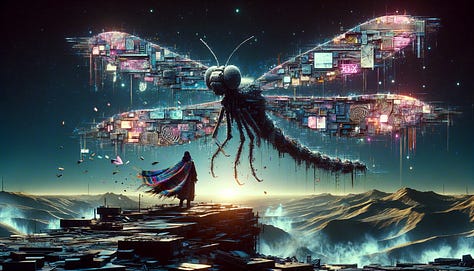
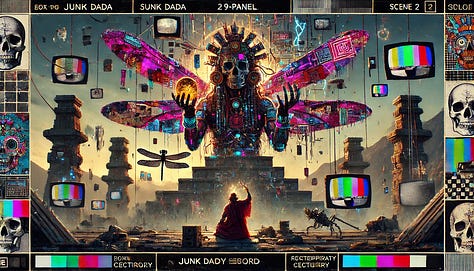
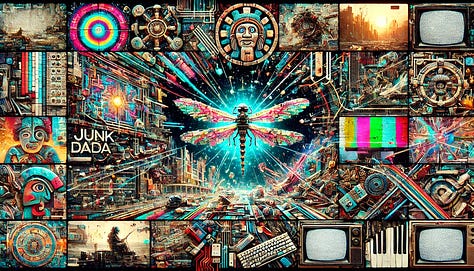
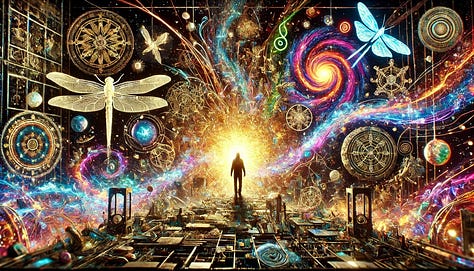
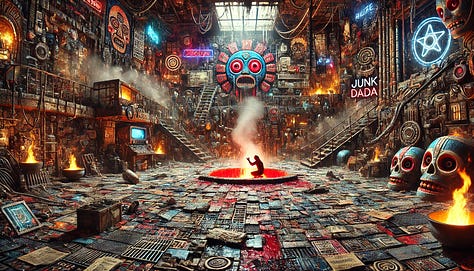
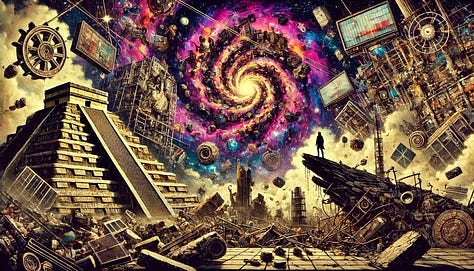
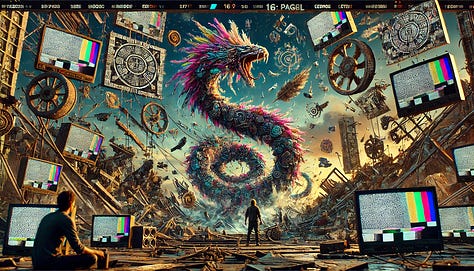
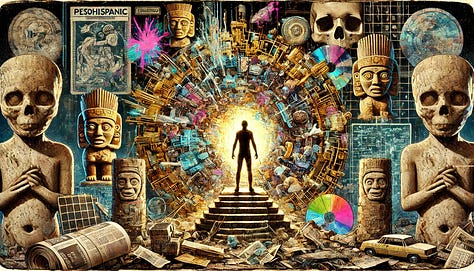
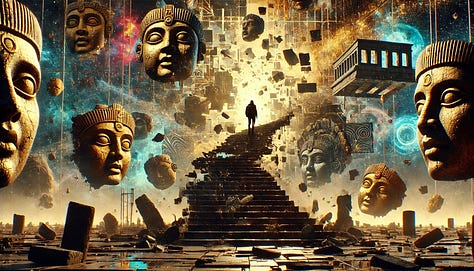
The Serpent and the Dragonfly

